Introduction
The experiment detailed below analyses several components and functionalities of Wi-Fi and LAN technologies. In the experiment, a number of units were analysed. The units included protocol analyser, network analyser, TCP/IP LAN technology, advanced LAN technology, rack server module, wireless LAN technology, and copper tool kit. Network monitoring analyser and AirMagnet Wi-Fi Analyser Pro software were also assessed in the experiment (IEEE, 2012). As the experiment was being conducted, the students were expected to observe and take notes. The notes indicated how the units were designed in real LAN networks. In one of the sessions, LAN Traffic V2 from ZTI Inc. was employed in the production of traffic for internet protocol networks. TCP, UDP, ICMP, and SCTP protocols were also utilised.
Theory and background
In the last few years, Wi-Fi technology has become so prevalent. The technology is widely used in colleges, companies, and homes as a substitute for wired LAN (Misra, 2010). LAN is used in reference to a computer network that serves a number of PCs in a local area. LAN network is utilised in offices, homes, or institutions (Peterson & Davie, 2011). Unlike WAN, LAN covers a limited geographical area. During the inception of the internet, ARCNET and Token Ring were preferred in the construction of LAN networks (Sarkar & Basavaraju, 2013). At present, Ethernet over twisted pair cabling and Wi-Fi have replaced the two designs. Notably, TCP/IP architecture is made up of a number of stratums (Williams, 2012). The stratums are application, transport, internet, and network. LAN network have switches. Smart switches are managed through a WEB interface. Authorised person should log into a web-based interface to program a smart switch.
Equipment setup & procedure
Unit 1-7 procedures setup and procedures:
- The students collected the communication and data devices from the computer lab
- The students differentiated protocol analyser, network analyser, TCP/IP LAN technology advanced LAN technology, rack server module, wireless LAN technology, and copper tool kit from other components.
- Thereafter, they analysed and noted the design of the units in real LAN networks.
Second session procedures:
- The students collected LAN Traffic V2 traffic generator software from the computer.
- The students initiated the sender part of the LAN Traffic V2
- Through it, they generated sixteen simultaneous UDP, TCP, and ICMP connections.
- Thereafter, the students programed the packet size with the help of the traffic data generator.
- As the experiment was being undertaken, the inter packet delay for each connection was documented.
- Later, they generated ICMP echoes using the ICMP protocol
- Lastly, using an automatic data generator the students evaluated, sequence-numbering errors, RTT average, jitter figures, and throughputs, received data, sent data
Third session procedures:
- The students collected a Wi-Fi Analyser from the computer lab
- Using the software, they practiced how to detect network connectivity issues.
- The students then practice how to conduct decoding and finding packets on decodes screen.
- Lastly, the students practiced how to turn on the spectrum analyser and detect interfering devices.
Wi-Fi Analyser discussion
With the help of the Wi-Fi Analyser software, the students practiced how to troubleshoot network problems with ease (AirMagnet, 2013). Using the software, they were able to address end-user problems. Correspondingly, the students practiced how to inspect signal strength, security risks, and Wi-Fi network susceptibilities using the software. Indicated below is a screenshot of a Wi-Fi Analyser.
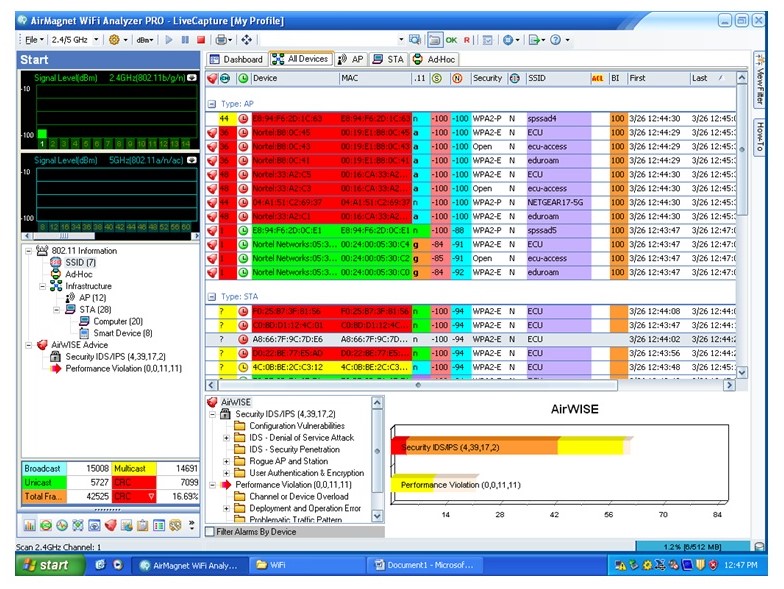
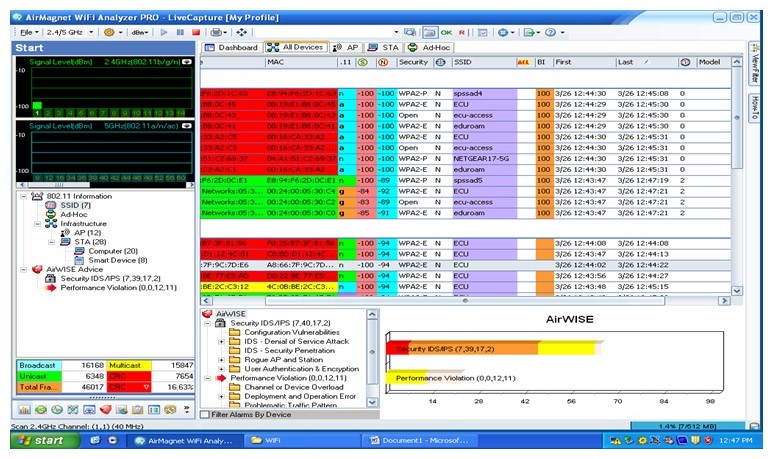

Based on the above screenshots, it is apparent that the sofware can be used in analysing network efficiency, network issues, device throughput, WLAN,and site RF signal distribution.
During the experiment, a number of screenshots were taken. Indicated below are some of the screenshots taken during the analysis.
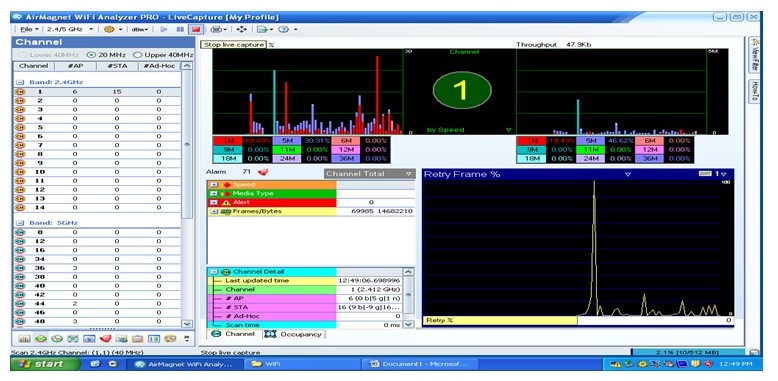
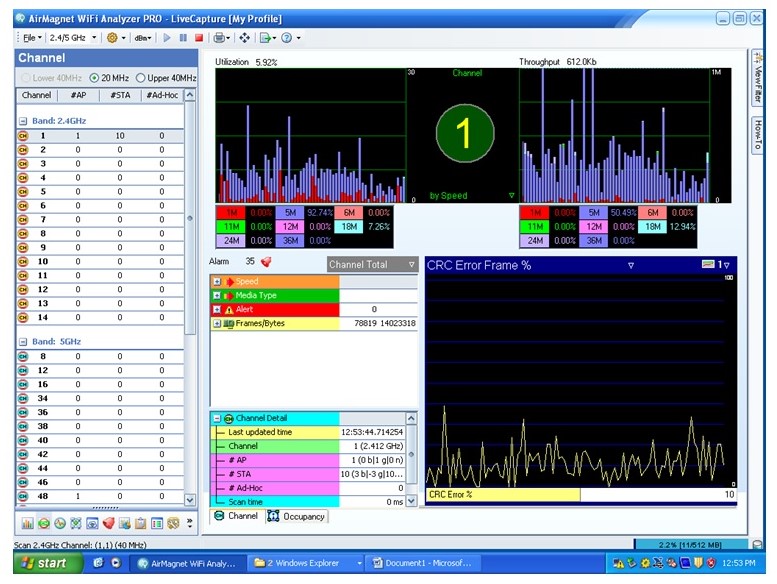
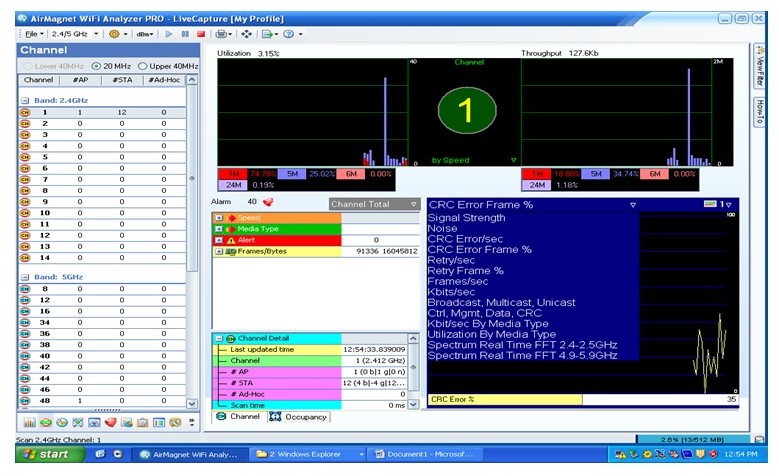

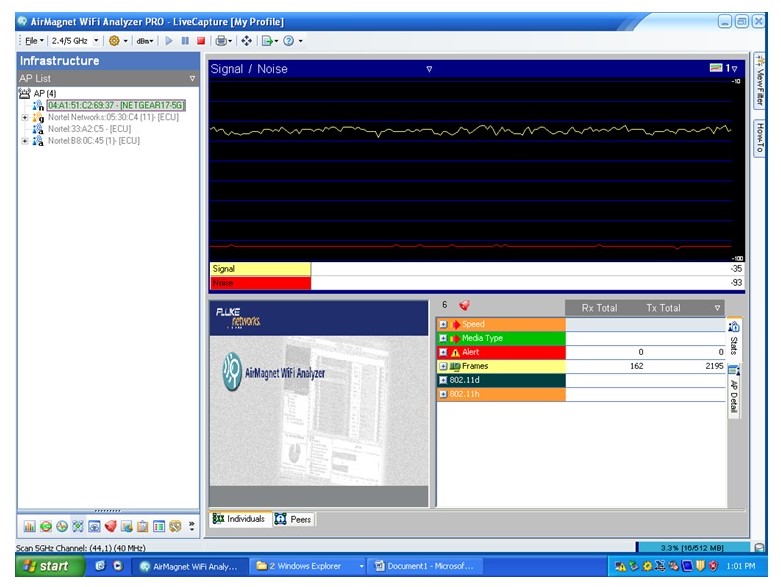
The software enabled the students to investigate network data between any chosen pair of AP and STA (AirMagnet, 2013). The screeenshots illustrated below were generated from the WLAN throughput simulator. The images captured the obtained network, node, and media throughput in a number of networks.
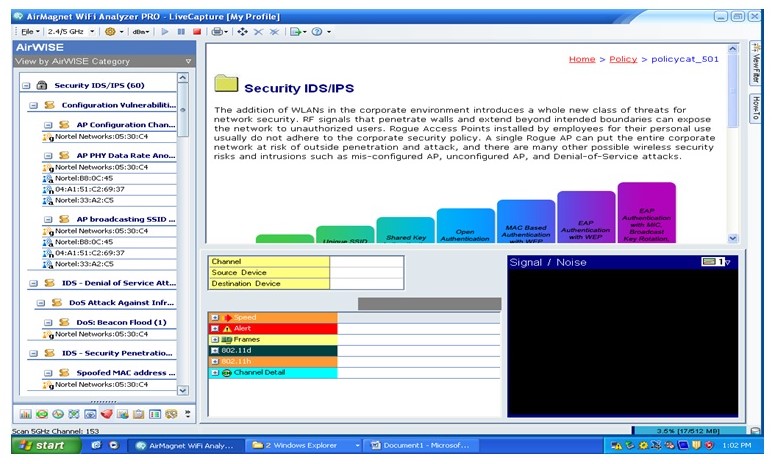
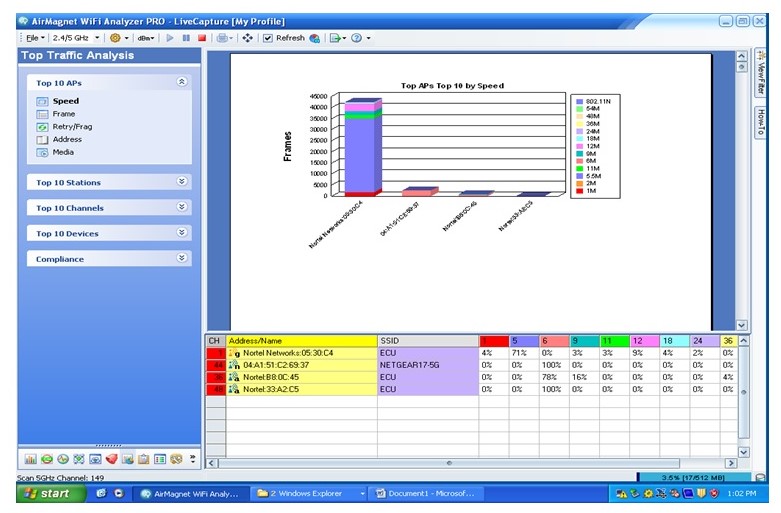
As indicated in the images above, authorized persons can program or add supplementary nodes into the system. The software is a vital tool for every IT technician. Through it, they can inspect and address several corporate wireless network operation problems.
LANTraffic V2 discussion
LANTraffic V2 software can be utilised in several windows platforms (ZTI Communications, 2013). During the experiment, students learnt that the software could be implemented using different protocols. It was also learnt that the tool utilises the Microsoft Windows TCP/IP stack. The transmission links used in the experiment were Ethernet, token-ring, hyper-Lan, WLAN, WAN, remote access, and PLC.
When LANTraffic V2 tool was initiated, the following image was displayed on the PC’s screen. Area 1 is the menu bar, area 2 is the tool bar, and area 3 is the list of opened scenarios. Similarly, area 4 is a working area whereas area 5 is the status bar.

A new file was generated by clicking on the file folder, selecting the window, double clicking on the command line, and selecting the chosen instruction to be placed in a chosen scenario. Afterward, the students were supposed to right click on the choosen command line to save the new scenario.
Conclusion
The experiment detailed above assessed a number of components and functionalities of Wi-Fi and LAN technologies. In the experiment, a number of units are noted. Through the experiment, learners analysed features of LAN Traffic V2. During the experiment, learners noted that LAN Traffic V2 could be implemented using a number of protocols. It was also noted that the tool utilises the Microsoft Windows TCP/IP stack. The transmission links used in the experiment were Ethernet, token-ring, hyper-Lan, WLAN, WAN, remote access, and PLC. The aim of the investigation was to study various network components like TCP/IP utilities, wireless network diagnostics, traffic on LANs, Power over Ethernet, network diagnostics, and analysis of protocols.
References
AirMagnet, A. (2013). AirMagnet WiFi Analyzer Pro. Web.
IEEE, I. (2012). IEEE 802 Standards. Web.
Misra, S. (2010). Selected topics in communication networks and distributed systems. England: Addison-Wesley.
Peterson, L., & Davie, B. (2011). Computer networks: A systems approach (2nd ed.). San Francisco, Calif.: Morgan Kaufmann.
Sarkar, S., & Basavaraju, T. (2013). Ad hoc mobile wireless networks principles, protocols, and applications (2nd ed.). Boca Raton: CRC Press.
Williams, R. (2012). Computer systems architecture: A networking approach. Harlow, England: Addison-Wesley.
ZTI Communications (2013).Traffic Generator for IP Networks. Web.
